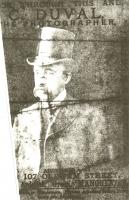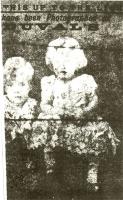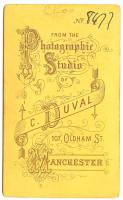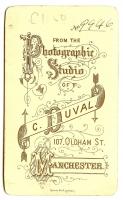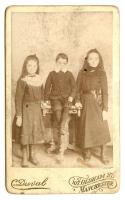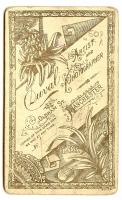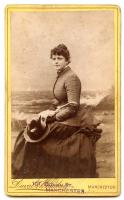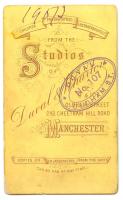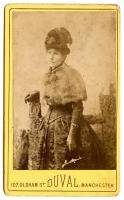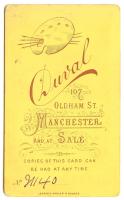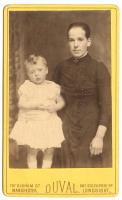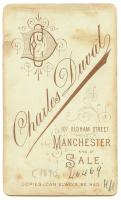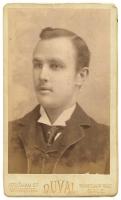
Charles Allen Du Val
His life and works
Charles Du Val
| Charles Duval |
|---|
| Born: 1835 Manchester |
| Died: 1893 Manchester |
| Father |
| Charles Allen Du Val |
| Mother |
| Elizabeth Renney |
| Siblings |
| Julia Du Val 1837-1888 |
| Edward James Du Val 1838-1923 |
| Gerald Du Val 1840-1895 |
| Florence Du Val 1842-1924 |
| Elizabeth Ellen Du Val 1844-1925 |
| Frances Du Val 1846-1920 |
| Catherine Sarah Du Val 1849-1873 |
| Norris Cartali Du Val 1851-1933 |
| Spouse |
| Elizabeth Atkinson |
| Children |
| Daisy Wilmer Duval 1884-1884 |
| Charles Duval 1885-1960 |
| Cecily Duval 1887-1912 |
| Kate Duval 1888-1888 |
Charles Du Val was born on 17 March 1835 (1), the eldest child of Charles Allen Du Val and his wife formerly Elizabeth Renney, and baptised in Manchester Collegiate Church on 7 March 1836. He used his surname in the form Duval.
On the left is shown the only known photograph of him, taken in about 1890 shortly before he died. On the right is a similar photograph of his children Charles and Cecily Duval taken in the same year. They are from two fragile "hold-to-light" paper prints, probably never intended for publication (2).
By Elizabeth Atkinson (3) he had the following children:
Daisy Wilmer Duval. She was born on 28 March 1884 and baptised on 9 April 1884 at St Luke's church, Chorlton-upon-Medlock. She died later in the same year.
Charles Duval. He was born on 7 September 1885, and died in 1960.
Cecily Duval. She was born on 6 January 1887, and died in 1912.
Kate Duval. She was born on 27 March 1888, and died aged only three months.
The family changed address several times in quick succession. In 1881 they were living at 2 Chapel Street in Ardwick in Manchester. In 1884 they were at 5 Burton Street in Chorlton-on-Medlock when Daisy was baptised, but by 1885 they were back in Ardwick at 2 Leigh Avenue, where Charles Duval 1885-1960 was born. They were in Cheetham in 1887 when Cecily was born. In 1888 the family were living at 687 Stockport Road, Newton, Prestwich. By April 1891, they were back in Ardwick.
Their father Charles Duval died suddenly on 12 August 1893 in Manchester (4).
Unlike his artist parents, Charles Duval does not seem to have been a painter. Instead he followed his father in the photographic side of the art world. When the firm of C.A. Du Val & Co was set up, the young Charles Duval managed it for his father, together with his brother-in-law Thomas George Whaite. After his father died in 1872, and Thomas George Whaite had left in 1881, that firm continued trading until 1886.
However Charles Duval set up his own business as a photographer in 1884, trading under his own name from 77 Oldham Street in Manchester (5). There were branches at 243 Cheetham Hill Road in Manchester and 158 Chapel Street in Salford, but these seem to have been short-lived. By 1886 the firm had moved to 107 Oldham Street, which remained the business address for the rest of its existence (6).
The firm was unusual in numbering their photographs by hand. If this numbering was chronological (as is probable) then the firm traded from 1884 as "C. Duval", briefly from about 1886 as "Duval and Wharton", then also briefly as "Duval", and from the late 1880s until 1912 as "Charles Duval" (7).
In the 1880s and 1890s carte-de-visite and cabinet photographs were extremely popular, and the firm of Charles Duval produced vast quantities of them. They appeared with various types of backs, mostly elegantly designed but sometimes in plain dark colours. Examples are known in which all three successive trading styles of the firm's name were used. Fortunately he usually numbered his photographs, and they can therefore be put into chronological order. All the sitters in the following examples are unknown.
Type A is an example of an early carte-de-visite produced by the firm of Charles Duval. It was probably made in 1885, and has the rounded corners typical of that period.
Type B is the back of a carte-de-visite photograph made after the firm had moved to 107 Oldham Street in Manchester. The photograph is numbered by hand, a feature of such photographs produced by this firm but seldom used by others.
Type C is a similar design, but this back was printed by Spicer Bros in London. Provision is now included for writing the number of the print in by hand.
Type D is a more elaborate design dating from the late 1880s. Although the style remains C. Duval on the front, that on the back is simply Duval. Space for the print number is awkwardly placed, and this carte is unnumbered.
Type E is particularly interesting. A back has been used from old stock, rubber-stamping the new address on front and back. Furthermore, by examining the design beneath the rubber stamp, it will be seen that this carte-de-visite dates from the period when the business was trading as Duval and Wharton.
By 1887 a branch had been opened at 19 Marsland Road in Sale, Cheshire. Type F is an example of a carte then produced. Interestingly the palette design is reminiscent of that formerly used by C.A. Du Val & Co. In 1890 the Sale address was incorporated into the design on the front of the cartes, as in Type G.
By 1892 a branch had also opened at 687 Stockport Road in Longsight in Manchester, and the Sale branch had by then evidently closed (Type H).
Cabinet photographs were also produced by the firm. These were a larger and more expensive format, and became popular from about 1885.
Type I is a typical example. Produced in about 1895, its back lists several addresses not otherwise known (9).
Type J is an unusual cabinet photograph in its horizontal layout. Taken at the 1886 Caerwys Eisteddfod, its caption is hand written.
(1) In the Du Val Family Scroll now in the possession of a descendant of his, Charles Allen Du Val wrote the name of his eldest son as Charles Allen Du Val like his own, but that middle name seems not to have been used by Charles Duval 1835-1891.
(2) From copies of two thin "hold-to-light" paper prints kindly provided by Audrey Linkman.
(3) She was the daughter of the Registrar of Carlisle. No marriage record has ever been found, and it is almost certain that they were never actually married.
(4) Manchester Evening News 26 August 1893.
(5) Manchester Directory page 116. 1884 is the earliest date on which the entry appears. There is none in the corresponding place in the 1883 Directory (page 113) or any earlier directory. Although the entry in the directories is always "Chas. Duval, photographer", the business traded at first as "C. Duval", then briefly as "Duval and Wharton", then again briefly as "Duval", and finally as "Charles Duval", as denoted on the cartes-de-visite produced. The directories are therefore only useful as providing the first and last years of trading and the business addresses. It must be borne in mind however that directories may be out-of-date in these respects when actually published.
(6) The last entry of the firm in the Manchester directories is in that for 1912 (page 1044).
(7) "Duval and Wharton" also traded from 243 Cheetham Hill Road in Manchester. The carte-de-visite ahown above as Type E has that trading name over-stamped by "Duval". That was briefly the trading style, but it was soon changed to "Charles Duval".
(8) The studio of Charles Duval remained at 107 Oldham Street until his death in 1893, after which the business was continued at the same address until 1912. Although by then in other hands, the premises were still a photographic business in 1992, and the old glass-house studio was still visible.
(9) By then Charles Duval was dead, and the firm was in other hands (8). However the name was continued, and now included an armorial crest and the motto “Non inferiora secutas”. It should be “Non inferiora secutus” meaning “Not having followed inferior things”. This was not the Du Val family motto, and was presumably invented by the new management for prestige purposes.
